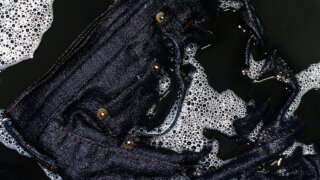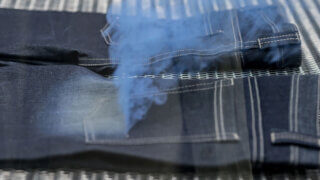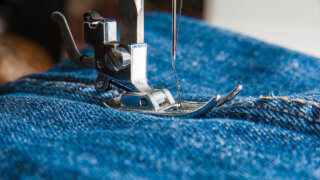Denim Finishing Machinery
Rotary Machines
Rotary drum machines are versatile and accommodate a wide range of fabric types and chemical processes so they are often used for a variety of wet processes. Most rotary machines are side-loading. They are similar to home front-loading washing machines in that they consist of an outer closed cylinder and an inner perforated drum or basket that rotates within the outer cylinder. An access door is located on the side of the outer cylinder. The key advantage of side-loading rotary drum machines is that they require relatively little water to operate.
Garments are loaded into the rotary machine through the outer access door. The door is closed and the external cylinder is filled to between one-quarter and one-third of its volume with water or a processing bath. As the interior drum rotates, the garments become saturated with the bath. Typically, after the drum rotates in one direction, for a specified number of cycles, the direction reverses. This prevents the garments from being tumbled into a dense mass keeps the bath being circulated evenly throughout the contents of the machine.
Side-Loading Rotary Machines
Side-loading rotary machines typically have one of three common types of drums or pockets: an open pocket, a Y pocket, or a lobed pocket. Each pocket has its advantages depending on the type of garment being processed. While open pockets are most often featured on belly washers, they are also used in some side-loading machines. The open pocket design maximizes tumbling and facilitates greater abrasion. Y pockets keep garments from tumbling freely which make them the best choice for items that need minimum agitation and abrasion. Finally, lobed pockets lift the garments allowing increased tumbling with controlled abrasion.
Rotary Drum Machines
Rotary drum machines have several advantages over other types of machines, for one they have microprocessors and computers that allow more precise, sophisticated process control that saves time and materials. Another benefit is their add tanks which can be programmed to add chemicals or dyestuffs automatically without operator intervention. Finally, rotary drum machines remove water or bath solution from garments by centrifugal extraction. This reduces both the number of chemicals or dyestuffs needed for processing and the volume of water needed for rinsing. Garments dry faster and with less energy use.
Front-Loading Machine (Belly Washer)
An older variation on the rotary machine is the front-loading machine or belly washer. These machines have multiple baskets inside the outer cylinder. As with side-loading machines, belly washers have an access door in the outer cylinder but the access door is located in the perimeter rather than the side of the cylinder making it more difficult to reach the inner drum or basket. Because of this restriction, belly washers aren’t as common as they once were but many finishing plants still use them for such processes as desizing and stone washing. This is because they are simple, inexpensive, and easy to use. Belly washers are also large. Some belly washers can hold up to 800 pounds of garments. The disadvantages of these machines though are that they require manual operation and high liquor ratios and lack a high-speed extractor. Liquor ratio is the weight of the water and other chemistries in the bath compared to the weight of the garments.
Wet Processing
Next, let’s take a quick look at how denim garments are wet-processed through rotary washing machines. Before wet processing can begin, denim garments must first be organized into processing lots. For example, one lot may consist of garments that have come directly from cut and sew. Another lot may have already received some type of preparatory process such as sanding or potassium permanganate treatment. Yet another might require additional processing following the wet process.
Processing lots are brought to the washer on a pallet, in a truck, or preloaded into a delivery system such as a sling. The individual processing load is determined by the liquor ratio of the particular processing process to be run. The number of garments in a load can be determined either by weight or by a set count. Modern rotary machines are able to tilt backward for loading and forward to unloading making both processes less complicated.
While belly washers are not able to tilt back for loading, the angle of the door opening makes them fairly easy to load. Typically items can be loaded by hand or, in some cases, by using a sling. For unloading, the machine’s baskets are lifted up and forward. Since belly washers do not have high-speed extractors, the saturated contents are very heavy often making unloading a strenuous job.
Extraction
Once wet processing is complete, the garments go through an extraction process to remove excess water, which minimizes drying time and energy use. Modern rotary machines have excellent extraction capabilities, which are often sufficient for drying. However, if too much water is extracted, unwanted folds and creases can form.
Older rotary machines and belly washers require a separate extraction using a machine designed specifically for that purpose.
After washing and extraction, the machine is tilted forward and a dyehouse truck with an open sling is place in front of it.
The operator then activates the drum so that as it turns, the garments tumble out of the drum and into the truck. The operator hand places that miss the sling. When the slings are full, they are placed in to a centrifugal extractor by either a forklift equipped with a boom or, in some cases, an overhead conveyor system. The sling positions are adjusted for weight balance and the door is closed. The extractor removes water from the garments by spinning the basket at high speed creating centrifugal force. When the process is completed, the door is opened and the slings are removed. They are then transported via forklift to a tumble dryer.
Tumble Drying
Once excess water has been removed, the next step is to tumble dry the garments. The dryer is tilted back for easy loading and the slings containing the garments are placed in side. The machine is then returned to its upright position and the drying process begins. The dryer uses heat, which evaporates the water and tumbling which softens and pre-shrinks the garment.
Most denim washing plants dedicate their dryers by depth of shade. The other colorants for cotton would be direct, reactive, vat, sulfur dyestuffs, and pigment colors.
Whites in particular require their own dryer. Most denim washing houses process white bull denim which would become stained if processed in a dryer where indigo shades have been dried.
Whites notwithstanding, most products which pass through the finishing house do at least maintain a medium indigo shade. These items are dried in a dryer marked indigo or dark. Resins and cross linkers are used to achieve effects currently in vogue such as age marks, including whiskers. They also help improve color retention, decrease shrinkage and result in cleaner surfaces.
Once drying is complete, most of today’s machines unload garments from the back. The garments are then placed on to a truck or conveyor belt for further processing.
Pressing
At various times during the denim finishing process, garments may be pressed to achieve a smooth or ironed appearance. For example, jeans are often pressed to provide a smooth surface for the application of whiskers. Creases or pleats may be pressed into a garment for a vintage look or jeans may be pressed, prior to curing, for a dressier look.
The most common systems for pressing denim jeans are the hot head press, the balloon steamer, and the hand iron.
The hot head press, or the buck press, is the same one used in all phases of garment manufacturing and in laundries. It consists of a lower table or board and an upper head. Jeans are placed perfectly flat on the lower table. The head is lowered, under pressure, onto the garment on the table. A cycle of pressure, steam, and vacuuming then presses the jeans.
The steaming cycle is often called baking. The automatic form press, or balloon steamer, does just what its name suggests: it balloons out to remove wrinkles from a garment. A pair of jeans is placed on the vertical systems so that the waistband surrounds the expandable top. The top grips the jeans and opens the waist. Each pant leg is then gripped at the bottom. The garment is then ballooned, or opened, by applying steam and pumping compressed air inside the garment.
The cycle of steam and expansion is followed by a vacuum step to remove residual moisture and cool the garments. The old reliable pressing system in homes and laundries around the world is the hand iron. In denim garment finishing, the hand irons use is restricted to developing accent effects such as whiskering and for touching up garments for final inspection and packaging. In many places, the hot head has replaced the steamer and the hand iron for these tasks since it gives a smoother, flatter finish.


